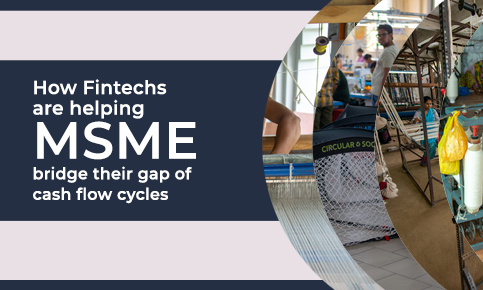How Fintechs are helping MSMEs bridge their gap of Cash Flow Cycles

India is home to 6.3 crore Micro, Medium and Small Enterprises (MSMEs). While MSMEs hold a major share in the Indian economy, they often face cash flow limitations. Until now, traditional banks were weary of extending capital assistance or loans to MSMEs citing their sporadic cash flow and volatile and vulnerable business cycle that largely depends on seasonality, labour costs, natural calamities etc.
| MSMEs contribute around 6.11% of the manufacturing GDP and 24.63% of the GDP from service activities as well as 33.4% of India’s manufacturing output. |
Today, the MSME sector is regarded as an “opportunity overlooked” by Fintechs, rather than a threat. This attitude is transforming how MSMEs were always viewed. Earlier, where MSMEs struggled availing capital for production, expansion etc., resulting in a build-up of non-performing assets, today they are being focussed on and empowered.
Availing credit from traditional banks often required a collateral or credit report that MSMEs did not possess and hence, made them ineligible for loans. Today, Fintechs are reshaping how MSMEs have access to working capital and manage their cash flow.
With the help of Artificial Intelligence, Machine Learning and Big data analysis, Fintechs analyse various aspects like credit risk, eligibility, cash flow, business behavioural pattern, etc. and ascertain a business’s credit limit thereby eliminating the need of preceding credit information. This has helped MSMEs since their eligibility does not solely depend on a collateral or credit information anymore rather, on their business pattern.
For instance, Niyogin Fintech Limited, an impact centric Neobank, focusses solely on empowering MSMEs. With the help of advanced algorithms, they generate end to end business analysis report that proves credit eligibility. The said algorithm analyses aspects like credit risk profile, credit eligibility, business cash flow, loan tenure, etc. With automated pricing and decision engines, loan disbursals are often quick.
Furthermore, Fintechs are bridging cash flow gaps by ascertaining current and projected cash flows of MSMEs and deploying technologies to get an accurate understanding of their cash conversion cycle. This analysis enables MSMEs avail financial assistance easily.
| The cash conversion cycle expresses the amount of time (in days) it takes for a company to convert its investments in inventory and other resources into cash flows from sales. |
Apart from lending, Fintechs are also enabling MSMEs manage their cash flow by digitizing their entire receivable and payment methods. This helps MSMEs fasten their cash flow in and out of business quickly. Where earlier 82% of small businesses failed due to poor cash flows and management, today by empowering MSMEs, India has seen an increase in MSMEs by 18.5% CAGR between 2019 to 2020.
Since MSMEs often use a single bank account, Fintechs have converted this into an opportunity by building technological solutions that check net cash flows and expenditure of the business. While this helps financial institutions in reducing their risk quotient when transacting with MSMEs, it acts as ‘digitization in the unorganized sector’ for MSMEs.
Fintechs have further allowed MSMEs invest their surplus income profitably through ‘smart investments’. For instance, Niyogin Fintech Ltd, through Moneyfront, offer Wealth Tech as a service. Based on mathematical set of rules, they analyse vital parameters like past performances and risk-return ratio, etc. & provide fund schemes that match your investment objective.
While traditional banks had rigid procedures, limited access to funds, technological barriers, Fintechs are working towards bridging the gap by innovating and digitizing solutions and processes, respectively, thereby improving and boosting cash flow cycle of MSMEs.

